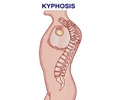Neuroscientists revealed on Wednesday they have achieved fresh advances in treating spinal injury by restoring breathing in lab rats whose key cervical nerves had been severed.

Damage above the fourth cervical vertebra in the neck invariably interrupts breathing. The patient has to be put on a ventilator, and this carries a recurrent danger of respiratory infection.
Under normal circumstances, the rate and depth of breathing are controlled automatically by nerve cells in the brain stem.
To do this, these neurons in turn control specialised motor cells located from the third to the sixth cervical vertebrae.
These cells develop farther down into the so-called phrenic nerve, which causes the muscles of the diaphram to relax and contract and the lungs to fill and empty.
A team led by Jerry Silver, a professor at Case Western Reserve University School of Medicine in Ohio, report on an experimental way of bridging damage in the key cervical area.
Advertisement
The idea was to use the peripheral nerve as a bridge on which the precursor cells for the phrenic nerve could grow.
Advertisement
To get around this, the researchers injected an enzyme called chondroitinase ABC at both ends of the graft to degrade the inhibitors and open up avenues in the scar tissue through which the nerves could -- hopefully -- grow.
After three months, tests showed that between 80 and 100 percent of breathing function had been restored, a performance that was maintained at the six-month mark.
"We've shown for the very first time that robust, long-distance regeneration can restore function of the respiratory system fully," Silver said in a press release, cautioning that further lab work was needed before the technique could be tried on human volunteers.
The study appears in the British journal Nature.
Silver added his lab had also begun preliminary work on restoring bladder function, which is often the top request for help from people who suffer lower spinal cord injuries.
Source-AFP












